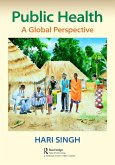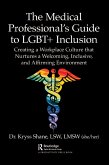

Alle Infos zum eBook verschenken

- Format: ePub
- Merkliste
- Auf die Merkliste
- Bewerten Bewerten
- Teilen
- Produkt teilen
- Produkterinnerung
- Produkterinnerung

Hier können Sie sich einloggen

Bitte loggen Sie sich zunächst in Ihr Kundenkonto ein oder registrieren Sie sich bei bücher.de, um das eBook-Abo tolino select nutzen zu können.
Public health is the science and art of improving the health and well-being of communities. Public health interventions go beyond individual healthcare to focus on preventing diseases and injuries, promoting healthy behaviors, and addressing sociocultural, economic, and environmental factors that impact health.
While topics of public health, such as maternal health, child health, and epidemiology of infectious and noncommunicable diseases, require familiarity with clinical terms and concepts, the author demystifies medical knowledge to make it accessible to a wider audience. Challenges…mehr
- Geräte: eReader
- mit Kopierschutz
- eBook Hilfe
![Public Health (eBook, PDF) Public Health (eBook, PDF)]() Hari SinghPublic Health (eBook, PDF)57,95 €
Hari SinghPublic Health (eBook, PDF)57,95 €![Nursing Informatics (eBook, ePUB) Nursing Informatics (eBook, ePUB)]() Nursing Informatics (eBook, ePUB)48,95 €
Nursing Informatics (eBook, ePUB)48,95 €![The Medical Professional's Guide to LGBT+ Inclusion (eBook, ePUB) The Medical Professional's Guide to LGBT+ Inclusion (eBook, ePUB)]() Kryss ShaneThe Medical Professional's Guide to LGBT+ Inclusion (eBook, ePUB)25,95 €
Kryss ShaneThe Medical Professional's Guide to LGBT+ Inclusion (eBook, ePUB)25,95 €![A Woman's Guide to Navigating a Successful Career in Healthcare Information Technology (eBook, ePUB) A Woman's Guide to Navigating a Successful Career in Healthcare Information Technology (eBook, ePUB)]() Jeffery DaigrepontA Woman's Guide to Navigating a Successful Career in Healthcare Information Technology (eBook, ePUB)41,95 €
Jeffery DaigrepontA Woman's Guide to Navigating a Successful Career in Healthcare Information Technology (eBook, ePUB)41,95 €![The Birth of Grapevine Health (eBook, ePUB) The Birth of Grapevine Health (eBook, ePUB)]() Lisa K. FitzpatrickThe Birth of Grapevine Health (eBook, ePUB)27,95 €
Lisa K. FitzpatrickThe Birth of Grapevine Health (eBook, ePUB)27,95 €![Managing Complexity in Healthcare (eBook, ePUB) Managing Complexity in Healthcare (eBook, ePUB)]() Lesley KuhnManaging Complexity in Healthcare (eBook, ePUB)21,95 €
Lesley KuhnManaging Complexity in Healthcare (eBook, ePUB)21,95 €![Renovating Healthcare IT (eBook, ePUB) Renovating Healthcare IT (eBook, ePUB)]() Susan SnedakerRenovating Healthcare IT (eBook, ePUB)51,95 €
Susan SnedakerRenovating Healthcare IT (eBook, ePUB)51,95 €-
-
-
While topics of public health, such as maternal health, child health, and epidemiology of infectious and noncommunicable diseases, require familiarity with clinical terms and concepts, the author demystifies medical knowledge to make it accessible to a wider audience. Challenges faced by low-income countries, as well as success stories from developed nations, are included to make the book relevant for global readers.
With a focus on essentials and priority issues, the author employs simple and straightforward language to present situational cases that shed light on global public health challenges and possible interventions. To stimulate analytical thinking and encourage readers to approach the subject with scientific rigor, concepts and facts are substantiated with their background, rationale, or application. Readers should be able to relate learnings with their field experience.
While this book is primarily for public health practitioners, including community health nurses and physicians, social workers, and health managers, it may be a valuable resource for anyone interested in public health and its application in creating healthier societies.
Dieser Download kann aus rechtlichen Gründen nur mit Rechnungsadresse in A, B, BG, CY, CZ, D, DK, EW, E, FIN, F, GR, HR, H, IRL, I, LT, L, LR, M, NL, PL, P, R, S, SLO, SK ausgeliefert werden.
- Produktdetails
- Verlag: Taylor & Francis eBooks
- Seitenzahl: 340
- Erscheinungstermin: 26. Juni 2024
- Englisch
- ISBN-13: 9781040026939
- Artikelnr.: 70634940
- Verlag: Taylor & Francis eBooks
- Seitenzahl: 340
- Erscheinungstermin: 26. Juni 2024
- Englisch
- ISBN-13: 9781040026939
- Artikelnr.: 70634940
- Herstellerkennzeichnung Die Herstellerinformationen sind derzeit nicht verfügbar.
Currently, Dr. Singh serves as dean of the School of Public Health at SRM Institute of Science and Technology in Chennai, India, where he teaches public health. He is passionate about developing technical content in a simple language to ensure his readers can easily understand complex medical and health topics.
Public Health? Chapter 2 Concept of Primary Health Care. Chapter 3 What Is
Health? Chapter 4 Determinants of Health. Chapter 5 What Are Infectious
Diseases? Chapter 6 What Are Noncommunicable Diseases? Chapter 7
Classification of Diseases. SECTION II Basic Epidemiology. Chapter 8 What
Is Epidemiology? Chapter 9 Disease Transmission. Chapter 10 Natural History
of Diseases. Chapter 11 Measuring Mortality. Chapter 12 Measuring
Morbidity. Chapter 13 Indirect Indicators of Health. Chapter 14 Disease
Surveillance. SECTION III Applied Epidemiology. Chapter 15 Screening of
Diseases. Chapter 16 Disease Prevention. Chapter 17 Epidemiological Study
Designs: An Introduction. Chapter 18 Descriptive Study. Chapter 19
Case-Control Study. Chapter 20 Cohort Study. Chapter 21 Experimental Study.
Chapter 22 Association and Causation. Chapter 23 Bias and Confounding.
Chapter 24 Epidemic Management. SECTION IV Biostatistics. Chapter 25 What
Is Biostatistics? Chapter 26 Organizing Data. Chapter 27 Analyzing Data.
Chapter 28 Measures of Dispersion. Chapter 29 Presenting Data. Chapter 30
Sampling Methods. Chapter 31 Tests of Significance. Chapter 32 Correlation
and Regression. SECTION V Public Health Nutrition. Chapter 33 Nutrition and
Nutrients. Chapter 34 Nutritional Assessment. Chapter 35 Protein-Energy
Malnutrition. Chapter 36 Iron-Deficiency Anemia. Chapter 37 Iodine
Deficiency Disorders. Chapter 38 Vitamin A Deficiency. Chapter 39 Other
Micronutrient Deficiencies. Chapter 40 Diet Planning. Chapter 41 Food
Fortification and Food Additives. Chapter 42 Meat Hygiene and Mushroom
Poisoning. SECTION VI Environmental Health. Chapter 43 What Is Environment?
Chapter 44 Air Pollution. Chapter 45 Water and Its Sources. Chapter 46
Water Pollution and Treatment. Chapter 47 Water Harvesting. Chapter 48
Solid Waste Management. Chapter 49 Human Excreta Disposal. Chapter 50
Hospital Waste Management. Chapter 51 Noise Pollution. Chapter 52
Radiation. Chapter 53 Pesticides. Chapter 54 Housing and Family. SECTION
VII Sociocultural Dimensions of Health. Chapter 55 Sociocultural Practices.
Chapter 56 Gender and Health. Chapter 57 Poverty and Social Security.
Chapter 58 Health-Seeking Behavior. SECTION VIII Maternal and Child Health.
Chapter 59 Maternal Health. Chapter 60 Adolescent Health. Chapter 61 Child
Health. Chapter 62 Integrated Management of Childhood Illness. Chapter 63
Immunization. Chapter 64 Family Planning Programs. Chapter 65 Methods of
Contraception. Chapter 66 What Is Demography? SECTION IX Health Promotion.
Chapter 67 Health Promotion and Health Communication. SECTION X Other
Topics of Public Health. Chapter 68 Health of the Elderly. Chapter 69
Mental Health: A Public Health Concern. Chapter 70 Occupational Health
Hazards. Chapter 71 Occupational Safety of Healthcare Workers. Chapter 72
Disaster Management. Chapter 73 Emerging Diseases. Chapter 74 International
Health. SECTION XI Management of Health Projects. Chapter 75 Health Project
Management. Chapter 76 Planning. Chapter 77 Implementation and Monitoring
and Evaluation. Chapter 78 Quality Improvement. Chapter 79 Basic
Communication Skills. Index.
Public Health? Chapter 2 Concept of Primary Health Care. Chapter 3 What Is
Health? Chapter 4 Determinants of Health. Chapter 5 What Are Infectious
Diseases? Chapter 6 What Are Noncommunicable Diseases? Chapter 7
Classification of Diseases. SECTION II Basic Epidemiology. Chapter 8 What
Is Epidemiology? Chapter 9 Disease Transmission. Chapter 10 Natural History
of Diseases. Chapter 11 Measuring Mortality. Chapter 12 Measuring
Morbidity. Chapter 13 Indirect Indicators of Health. Chapter 14 Disease
Surveillance. SECTION III Applied Epidemiology. Chapter 15 Screening of
Diseases. Chapter 16 Disease Prevention. Chapter 17 Epidemiological Study
Designs: An Introduction. Chapter 18 Descriptive Study. Chapter 19
Case-Control Study. Chapter 20 Cohort Study. Chapter 21 Experimental Study.
Chapter 22 Association and Causation. Chapter 23 Bias and Confounding.
Chapter 24 Epidemic Management. SECTION IV Biostatistics. Chapter 25 What
Is Biostatistics? Chapter 26 Organizing Data. Chapter 27 Analyzing Data.
Chapter 28 Measures of Dispersion. Chapter 29 Presenting Data. Chapter 30
Sampling Methods. Chapter 31 Tests of Significance. Chapter 32 Correlation
and Regression. SECTION V Public Health Nutrition. Chapter 33 Nutrition and
Nutrients. Chapter 34 Nutritional Assessment. Chapter 35 Protein-Energy
Malnutrition. Chapter 36 Iron-Deficiency Anemia. Chapter 37 Iodine
Deficiency Disorders. Chapter 38 Vitamin A Deficiency. Chapter 39 Other
Micronutrient Deficiencies. Chapter 40 Diet Planning. Chapter 41 Food
Fortification and Food Additives. Chapter 42 Meat Hygiene and Mushroom
Poisoning. SECTION VI Environmental Health. Chapter 43 What Is Environment?
Chapter 44 Air Pollution. Chapter 45 Water and Its Sources. Chapter 46
Water Pollution and Treatment. Chapter 47 Water Harvesting. Chapter 48
Solid Waste Management. Chapter 49 Human Excreta Disposal. Chapter 50
Hospital Waste Management. Chapter 51 Noise Pollution. Chapter 52
Radiation. Chapter 53 Pesticides. Chapter 54 Housing and Family. SECTION
VII Sociocultural Dimensions of Health. Chapter 55 Sociocultural Practices.
Chapter 56 Gender and Health. Chapter 57 Poverty and Social Security.
Chapter 58 Health-Seeking Behavior. SECTION VIII Maternal and Child Health.
Chapter 59 Maternal Health. Chapter 60 Adolescent Health. Chapter 61 Child
Health. Chapter 62 Integrated Management of Childhood Illness. Chapter 63
Immunization. Chapter 64 Family Planning Programs. Chapter 65 Methods of
Contraception. Chapter 66 What Is Demography? SECTION IX Health Promotion.
Chapter 67 Health Promotion and Health Communication. SECTION X Other
Topics of Public Health. Chapter 68 Health of the Elderly. Chapter 69
Mental Health: A Public Health Concern. Chapter 70 Occupational Health
Hazards. Chapter 71 Occupational Safety of Healthcare Workers. Chapter 72
Disaster Management. Chapter 73 Emerging Diseases. Chapter 74 International
Health. SECTION XI Management of Health Projects. Chapter 75 Health Project
Management. Chapter 76 Planning. Chapter 77 Implementation and Monitoring
and Evaluation. Chapter 78 Quality Improvement. Chapter 79 Basic
Communication Skills. Index.







